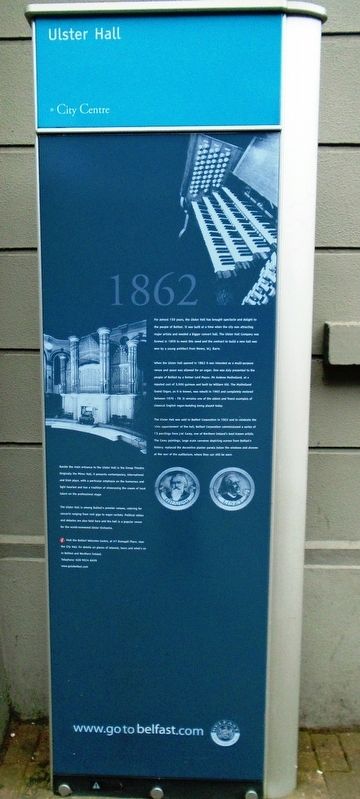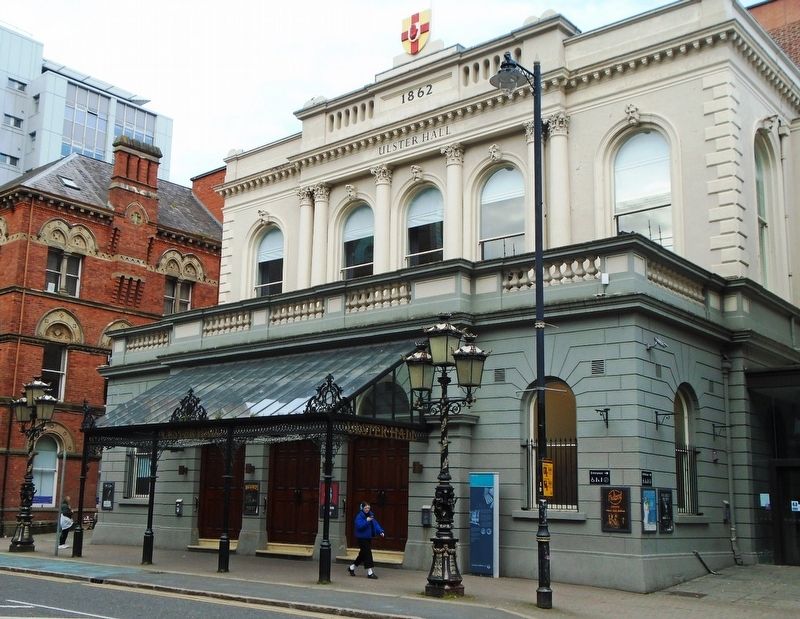Ulster Hall
City Centre
— 1862 —
For almost 150 years, the Ulster Hall has brought spectacle and delight to the people of Belfast. It was built at a time when the city was attracting major artists and needed a bigger concert hall. The Ulster Hall Company was formed in 1859 to meet this need and the contract to build a new hall was won by a young architect from Newry, W.J. Barre.
When the Ulster Hall opened in 1862 it was intended as a multi-purpose venue and space was allowed for an organ. One was duly presented to the people of Belfast by a former Lord Mayor, Mr Andrew Mulholland, at a reputed cost of 3,000 guineas and built by William Hill. The Mulholland Grand Organ, as it is known, was rebuilt in 1903 and completely restored between 1976 - 78. It remains one of the oldest and finest examples of classical English organ-building being played today.
The Ulster Hall was sold to Belfast Corporation in 1902 and to celebrate the ‘civic appointment’ of the hall, Belfast Corporation commissioned a series of 13 paintings from J.W. Carey, one of Northern Ireland’s best known artists. The Carey paintings, large scale canvases depicting scenes from Belfast’s history, replaced the decorative plaster panels below the windows and alcoves at the rear of the auditorium, where they can still be seen.
Beside the main entrance to the Ulster Hall is the Group Theatre.
Originally the Minor Hall, it presents contemporary, international and Irish plays, with a particular emphasis on the humourous and light hearted and has a tradition of showcasing the cream of local talent on the professional stage.
The Ulster Hall is among Belfast’s premier venues, catering for concerts ranging from rock gigs to organ recitals. Political rallies and debates are also held here and the hall is a popular venue for the world-renowned Ulster Orchestra.
Erected by the City of Belfast.
Topics. This historical marker is listed in these topic lists: Architecture • Arts, Letters, Music • Entertainment • Man-Made Features. A significant historical year for this entry is 1859.
Location. 54° 35.675′ N, 5° 55.864′ W. Marker is in Belfast, Northern Ireland. Marker is on Bedford Street just south of Franklin Street, on the left when traveling south. Touch for map. Marker is at or near this postal address: 34 Bedford Street, Belfast, Northern Ireland BT2 7FF, United Kingdom. Touch for directions.
Other nearby markers. At least 8 other markers are within walking distance of this marker. Bedford Street (about 120 meters away, measured in a direct line); BBC Broadcasting House (about 120 meters away); Sir Otto Jaffe (about 150 meters away); Donegall Square South (about 150 meters away); Donegall Square West (about 150
Credits. This page was last revised on May 24, 2019. It was originally submitted on May 24, 2019, by William Fischer, Jr. of Scranton, Pennsylvania. This page has been viewed 257 times since then and 23 times this year. Photos: 1, 2. submitted on May 24, 2019, by William Fischer, Jr. of Scranton, Pennsylvania.

